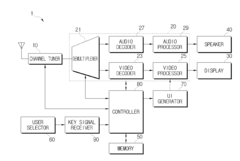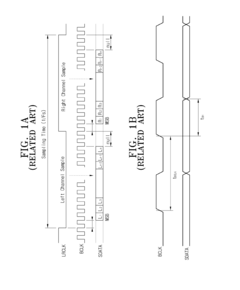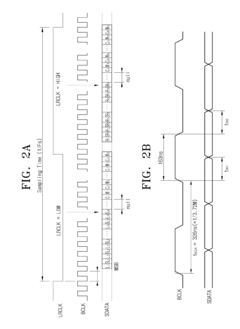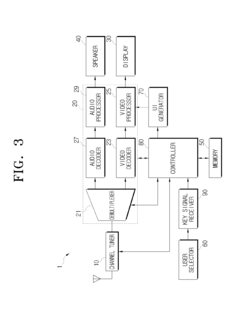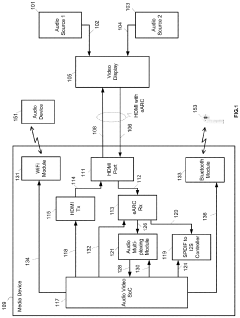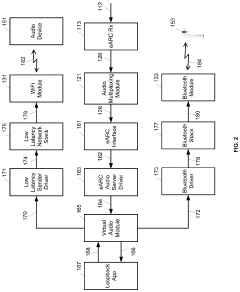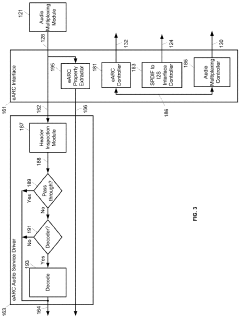LDAC Audio Streaming: Best Practices and Techniques
JUL 4, 20258 MIN READ
Generate Your Research Report Instantly with AI Agent
Patsnap Eureka helps you evaluate technical feasibility & market potential.
LDAC Technology Overview
LDAC (Low Latency Audio Codec) is a proprietary audio coding technology developed by Sony Corporation. It is designed to deliver high-quality wireless audio transmission over Bluetooth connections. LDAC aims to address the limitations of traditional Bluetooth audio codecs by offering higher bitrates and improved audio fidelity.
The technology was first introduced in 2015 and has since gained widespread adoption in the audio industry. LDAC supports audio transmission at up to 990 kbps, which is significantly higher than the standard SBC (Subband Coding) codec used in most Bluetooth audio devices. This increased bitrate allows for the transmission of high-resolution audio content, preserving more of the original audio quality.
LDAC employs advanced encoding techniques to maximize audio quality while maintaining efficient data transmission. It utilizes a hybrid coding system that combines lossless and lossy compression methods. The codec dynamically adjusts its compression ratio based on the available bandwidth and signal strength, ensuring optimal performance across various usage scenarios.
One of the key features of LDAC is its ability to transmit 24-bit/96 kHz audio content wirelessly. This capability makes it particularly appealing for audiophiles and music enthusiasts who demand high-fidelity sound reproduction. LDAC also supports multiple audio quality modes, allowing users to prioritize either sound quality or connection stability based on their preferences and environmental conditions.
The adoption of LDAC has been facilitated by its integration into the Android operating system since version 8.0 (Oreo). This integration has made the technology accessible to a wide range of Android-powered devices, including smartphones, tablets, and digital audio players. Additionally, many audio equipment manufacturers have incorporated LDAC support into their products, including headphones, speakers, and home audio systems.
While LDAC offers significant improvements in audio quality, it does have some limitations. The technology requires compatible hardware on both the transmitting and receiving devices. Furthermore, the higher bitrates used by LDAC can potentially impact battery life, especially on smaller devices like wireless earbuds.
As the demand for high-quality wireless audio continues to grow, LDAC remains a prominent technology in the field. Its ability to deliver near-lossless audio over Bluetooth connections positions it as a valuable solution for consumers seeking premium audio experiences in wireless setups.
The technology was first introduced in 2015 and has since gained widespread adoption in the audio industry. LDAC supports audio transmission at up to 990 kbps, which is significantly higher than the standard SBC (Subband Coding) codec used in most Bluetooth audio devices. This increased bitrate allows for the transmission of high-resolution audio content, preserving more of the original audio quality.
LDAC employs advanced encoding techniques to maximize audio quality while maintaining efficient data transmission. It utilizes a hybrid coding system that combines lossless and lossy compression methods. The codec dynamically adjusts its compression ratio based on the available bandwidth and signal strength, ensuring optimal performance across various usage scenarios.
One of the key features of LDAC is its ability to transmit 24-bit/96 kHz audio content wirelessly. This capability makes it particularly appealing for audiophiles and music enthusiasts who demand high-fidelity sound reproduction. LDAC also supports multiple audio quality modes, allowing users to prioritize either sound quality or connection stability based on their preferences and environmental conditions.
The adoption of LDAC has been facilitated by its integration into the Android operating system since version 8.0 (Oreo). This integration has made the technology accessible to a wide range of Android-powered devices, including smartphones, tablets, and digital audio players. Additionally, many audio equipment manufacturers have incorporated LDAC support into their products, including headphones, speakers, and home audio systems.
While LDAC offers significant improvements in audio quality, it does have some limitations. The technology requires compatible hardware on both the transmitting and receiving devices. Furthermore, the higher bitrates used by LDAC can potentially impact battery life, especially on smaller devices like wireless earbuds.
As the demand for high-quality wireless audio continues to grow, LDAC remains a prominent technology in the field. Its ability to deliver near-lossless audio over Bluetooth connections positions it as a valuable solution for consumers seeking premium audio experiences in wireless setups.
LDAC Market Analysis
The LDAC audio codec, developed by Sony, has gained significant traction in the high-quality wireless audio streaming market. As consumer demand for premium audio experiences continues to grow, LDAC has positioned itself as a leading technology in this space. The market for LDAC-enabled devices has seen robust growth, driven by the increasing adoption of wireless headphones, speakers, and other audio peripherals.
The global wireless audio market, which LDAC serves, was valued at approximately $20 billion in 2020 and is projected to reach $40 billion by 2026, with a compound annual growth rate (CAGR) of around 12%. LDAC's ability to transmit high-resolution audio wirelessly has made it particularly attractive to audiophiles and music enthusiasts, contributing to its market expansion.
In the smartphone segment, LDAC has been integrated into numerous Android devices, expanding its potential user base. This integration has been facilitated by Google's inclusion of LDAC in the Android Open Source Project (AOSP) since Android 8.0 Oreo. As a result, many Android smartphone manufacturers have adopted LDAC, increasing its market penetration.
The headphone and earphone market has been a key driver for LDAC adoption. With the growing popularity of true wireless stereo (TWS) earbuds, manufacturers are increasingly incorporating LDAC to differentiate their products in the premium segment. This trend is expected to continue as consumers seek higher quality audio experiences in compact, wireless form factors.
In the automotive sector, LDAC is gaining traction as car manufacturers focus on enhancing in-vehicle entertainment systems. The technology's ability to deliver high-quality audio over Bluetooth makes it an attractive option for premium car audio systems, potentially opening up new market opportunities.
The professional audio market, including recording studios and live sound reinforcement, has also shown interest in LDAC technology. While traditional wired solutions still dominate this sector, the increasing quality and reliability of wireless audio transmission technologies like LDAC are beginning to make inroads.
Geographically, Asia-Pacific leads in LDAC adoption, driven by strong consumer electronics markets in countries like Japan, South Korea, and China. North America and Europe follow closely, with growing demand for high-quality wireless audio solutions in these regions.
Despite its strengths, LDAC faces competition from other high-quality wireless audio codecs such as aptX HD and LHDC. The market's evolution will likely be influenced by factors such as codec licensing strategies, integration with popular devices and platforms, and the ability to meet evolving consumer expectations for audio quality and battery life in wireless devices.
The global wireless audio market, which LDAC serves, was valued at approximately $20 billion in 2020 and is projected to reach $40 billion by 2026, with a compound annual growth rate (CAGR) of around 12%. LDAC's ability to transmit high-resolution audio wirelessly has made it particularly attractive to audiophiles and music enthusiasts, contributing to its market expansion.
In the smartphone segment, LDAC has been integrated into numerous Android devices, expanding its potential user base. This integration has been facilitated by Google's inclusion of LDAC in the Android Open Source Project (AOSP) since Android 8.0 Oreo. As a result, many Android smartphone manufacturers have adopted LDAC, increasing its market penetration.
The headphone and earphone market has been a key driver for LDAC adoption. With the growing popularity of true wireless stereo (TWS) earbuds, manufacturers are increasingly incorporating LDAC to differentiate their products in the premium segment. This trend is expected to continue as consumers seek higher quality audio experiences in compact, wireless form factors.
In the automotive sector, LDAC is gaining traction as car manufacturers focus on enhancing in-vehicle entertainment systems. The technology's ability to deliver high-quality audio over Bluetooth makes it an attractive option for premium car audio systems, potentially opening up new market opportunities.
The professional audio market, including recording studios and live sound reinforcement, has also shown interest in LDAC technology. While traditional wired solutions still dominate this sector, the increasing quality and reliability of wireless audio transmission technologies like LDAC are beginning to make inroads.
Geographically, Asia-Pacific leads in LDAC adoption, driven by strong consumer electronics markets in countries like Japan, South Korea, and China. North America and Europe follow closely, with growing demand for high-quality wireless audio solutions in these regions.
Despite its strengths, LDAC faces competition from other high-quality wireless audio codecs such as aptX HD and LHDC. The market's evolution will likely be influenced by factors such as codec licensing strategies, integration with popular devices and platforms, and the ability to meet evolving consumer expectations for audio quality and battery life in wireless devices.
LDAC Technical Challenges
LDAC, as an advanced audio codec technology, faces several technical challenges in its implementation and optimization for audio streaming. One of the primary challenges is maintaining high audio quality while achieving efficient compression. LDAC aims to deliver near-lossless audio quality over Bluetooth connections, which requires sophisticated algorithms to compress audio data without significant loss of fidelity.
The codec must balance the trade-off between audio quality and transmission bandwidth, adapting to varying Bluetooth connection conditions. This dynamic adaptation is crucial for ensuring a stable and high-quality audio stream, especially in environments with potential interference or signal degradation. The complexity of the encoding and decoding processes also presents challenges in terms of computational requirements and power consumption, particularly for mobile devices with limited resources.
Another significant challenge lies in minimizing latency during audio transmission. Low latency is critical for applications such as gaming and video synchronization, where audio-visual alignment is essential. LDAC must optimize its encoding and decoding processes to reduce processing time while maintaining high audio quality, a task that becomes increasingly difficult as audio resolution and bit depth increase.
Compatibility across different devices and platforms poses another technical hurdle. LDAC needs to ensure seamless integration with various hardware configurations and operating systems, requiring robust implementation and thorough testing across a wide range of devices. This challenge is compounded by the need to maintain backward compatibility with older Bluetooth standards and devices.
The codec's ability to handle diverse audio formats and sampling rates efficiently is also a significant technical consideration. LDAC must be capable of processing and transmitting various audio formats, from standard CD-quality to high-resolution audio, without introducing artifacts or degradation. This versatility demands sophisticated signal processing techniques and adaptive encoding strategies.
Furthermore, LDAC faces challenges in optimizing its performance for different types of audio content. The codec must be equally effective in transmitting complex orchestral pieces, bass-heavy electronic music, and spoken word content, each with its unique spectral characteristics. Developing algorithms that can adapt to these varied audio profiles while maintaining consistent quality is a complex technical task.
Lastly, as wireless audio streaming continues to evolve, LDAC must address emerging challenges such as multi-channel audio support for immersive sound experiences and integration with new wireless technologies beyond traditional Bluetooth. These advancements require ongoing research and development to ensure LDAC remains at the forefront of wireless audio technology.
The codec must balance the trade-off between audio quality and transmission bandwidth, adapting to varying Bluetooth connection conditions. This dynamic adaptation is crucial for ensuring a stable and high-quality audio stream, especially in environments with potential interference or signal degradation. The complexity of the encoding and decoding processes also presents challenges in terms of computational requirements and power consumption, particularly for mobile devices with limited resources.
Another significant challenge lies in minimizing latency during audio transmission. Low latency is critical for applications such as gaming and video synchronization, where audio-visual alignment is essential. LDAC must optimize its encoding and decoding processes to reduce processing time while maintaining high audio quality, a task that becomes increasingly difficult as audio resolution and bit depth increase.
Compatibility across different devices and platforms poses another technical hurdle. LDAC needs to ensure seamless integration with various hardware configurations and operating systems, requiring robust implementation and thorough testing across a wide range of devices. This challenge is compounded by the need to maintain backward compatibility with older Bluetooth standards and devices.
The codec's ability to handle diverse audio formats and sampling rates efficiently is also a significant technical consideration. LDAC must be capable of processing and transmitting various audio formats, from standard CD-quality to high-resolution audio, without introducing artifacts or degradation. This versatility demands sophisticated signal processing techniques and adaptive encoding strategies.
Furthermore, LDAC faces challenges in optimizing its performance for different types of audio content. The codec must be equally effective in transmitting complex orchestral pieces, bass-heavy electronic music, and spoken word content, each with its unique spectral characteristics. Developing algorithms that can adapt to these varied audio profiles while maintaining consistent quality is a complex technical task.
Lastly, as wireless audio streaming continues to evolve, LDAC must address emerging challenges such as multi-channel audio support for immersive sound experiences and integration with new wireless technologies beyond traditional Bluetooth. These advancements require ongoing research and development to ensure LDAC remains at the forefront of wireless audio technology.
LDAC Implementation
01 LDAC codec for high-quality audio streaming
LDAC is a high-quality audio codec developed for Bluetooth audio streaming. It offers higher bitrates and better audio quality compared to standard Bluetooth codecs, allowing for near-lossless audio transmission over wireless connections. LDAC supports various sampling rates and bit depths, enabling more detailed and accurate sound reproduction.- LDAC codec for high-quality audio streaming: LDAC is a high-resolution audio codec developed for Bluetooth audio streaming. It offers improved audio quality by supporting higher bitrates and a wider frequency range compared to standard Bluetooth codecs. LDAC allows for the transmission of high-resolution audio content wirelessly, maintaining better sound quality during streaming.
- Adaptive bitrate control for audio streaming: Adaptive bitrate control techniques are used to optimize audio streaming quality based on network conditions. These methods dynamically adjust the bitrate of the audio stream to maintain the best possible quality while preventing dropouts or interruptions. This approach ensures a smooth listening experience even in varying network environments.
- Multi-channel audio streaming enhancements: Advancements in multi-channel audio streaming focus on improving the spatial audio experience. These techniques involve optimizing the transmission and processing of multiple audio channels to deliver immersive surround sound over wireless connections. This enhances the overall audio quality and listening experience for users of streaming services.
- Error concealment and packet loss mitigation: To maintain high audio quality during streaming, various error concealment and packet loss mitigation techniques are employed. These methods help to minimize the impact of data loss or corruption during transmission, ensuring that the perceived audio quality remains high even in less-than-ideal network conditions.
- Integration with smart audio devices and systems: The integration of high-quality audio streaming technologies with smart audio devices and home entertainment systems is a key focus. This includes developing seamless connectivity between streaming services, mobile devices, and audio equipment to provide an enhanced and user-friendly listening experience across various platforms and environments.
02 Adaptive bitrate and quality control
LDAC implements adaptive bitrate and quality control mechanisms to maintain optimal audio performance under varying wireless conditions. The codec can dynamically adjust its bitrate and encoding parameters based on the connection quality, ensuring a stable and high-quality audio stream even in challenging environments.Expand Specific Solutions03 Multi-channel audio support
LDAC supports multi-channel audio streaming, allowing for immersive surround sound experiences in wireless audio applications. This feature enables the transmission of high-quality, multi-channel audio content over Bluetooth connections, enhancing the overall listening experience for users of compatible devices.Expand Specific Solutions04 Integration with audio processing systems
LDAC can be integrated into various audio processing systems and devices, including smartphones, headphones, speakers, and home entertainment systems. This integration allows for seamless high-quality audio streaming across different platforms and devices, enhancing the overall user experience in multimedia applications.Expand Specific Solutions05 Compatibility and interoperability
LDAC is designed to be compatible with existing Bluetooth audio protocols and devices. It can coexist with other codecs and automatically negotiate the best available audio quality based on device capabilities. This ensures broad compatibility and interoperability across different audio devices and platforms while still offering superior audio quality when supported.Expand Specific Solutions
LDAC Industry Players
The LDAC Audio Streaming technology market is in a growth phase, with increasing adoption in high-end audio devices. The market size is expanding as consumers demand higher quality wireless audio experiences. Technologically, LDAC is relatively mature, with key players like Sony, the technology's developer, leading implementation. Other major companies such as LG Electronics, Samsung Electronics, and Apple are also active in this space, integrating LDAC support into their products. Research institutions like Fraunhofer-Gesellschaft and Electronics & Telecommunications Research Institute are contributing to advancements in audio codec technologies. The competitive landscape is characterized by a mix of consumer electronics giants and specialized audio technology firms, all vying to enhance wireless audio streaming capabilities.
Samsung Electronics Co., Ltd.
Technical Solution: Samsung has incorporated LDAC support into their Galaxy series smartphones and audio devices. Their implementation focuses on wide compatibility and user-friendly features. Samsung's approach includes integration with their Scalable Codec technology, which allows for dynamic bitrate adjustment similar to LDAC's adaptive bitrate control[6]. They have also developed a dual audio feature that enables simultaneous streaming to two Bluetooth devices while maintaining high audio quality[7]. Samsung's implementation emphasizes versatility, supporting various audio codecs including LDAC, aptX, and AAC.
Strengths: Wide device compatibility, innovative features like dual audio. Weaknesses: Potential fragmentation across different Samsung device models.
Sony Group Corp.
Technical Solution: Sony, as the developer of LDAC, has implemented advanced techniques for high-quality audio streaming. Their approach includes adaptive bit rate control, which dynamically adjusts the transmission rate based on wireless conditions, ensuring optimal audio quality and stability[1]. Sony's LDAC codec supports up to 990 kbps bitrate, allowing for transmission of high-resolution audio up to 32-bit/96 kHz[2]. They have also integrated LDAC with their DSEE Extreme AI upscaling technology, which enhances compressed audio files in real-time, improving the overall listening experience[3].
Strengths: Proprietary technology, highest bitrate support, AI-enhanced audio processing. Weaknesses: Limited compatibility with non-Sony devices, potential for higher power consumption.
LDAC Core Innovations
Audio data transmission and reception methods and electronic apparatus using the same
PatentInactiveUS20090024236A1
Innovation
- The method involves transmitting and receiving audio sample data at the falling edges of the bit clock and during null intervals, using a second clock signal with a frequency several times higher than the first clock signal, allowing for 5.1 channel audio data transmission without additional I/O interfaces, and ensuring compatibility with conventional audio data reception ICs.
Audio Return Channel Data Loopback
PatentActiveUS20210098011A1
Innovation
- A media device substitutes an externally generated clock derived from a local crystal oscillator for the missing sampling clock, synchronizing it with the input sampling clock frequency, and switches back when the input clock reappears, while inserting zero padding to mitigate sound glitches, and optionally buffers audio data during clock transitions to maintain sound continuity.
LDAC Compatibility
LDAC compatibility is a crucial aspect of implementing high-quality audio streaming using Sony's LDAC codec. This advanced audio coding technology offers superior sound quality over Bluetooth connections, but its effectiveness relies heavily on device compatibility and proper implementation.
LDAC is primarily supported by Android devices running Android 8.0 (Oreo) or later. However, not all Android devices with these operating systems have LDAC capabilities, as it requires specific hardware support. Manufacturers must license LDAC technology from Sony and integrate it into their devices' Bluetooth audio systems.
On the transmitting side, smartphones, tablets, and digital audio players that support LDAC can stream high-quality audio to compatible receivers. On the receiving end, various devices such as wireless headphones, speakers, and home audio systems can be equipped with LDAC decoding capabilities.
To ensure optimal LDAC performance, both the transmitting and receiving devices must support the codec. When two LDAC-compatible devices are paired, they negotiate the highest possible quality setting based on the current Bluetooth connection strength and stability. LDAC offers three quality modes: 330 kbps, 660 kbps, and 990 kbps, with the latter providing the highest audio quality.
Developers implementing LDAC streaming should be aware of potential compatibility issues with older or non-LDAC devices. It's essential to include fallback options to ensure seamless audio playback across a wide range of devices. This typically involves supporting other widely used codecs such as SBC, AAC, or aptX.
For maximum compatibility and user satisfaction, applications should dynamically detect the available audio codecs on connected devices and automatically select the highest quality option. This approach ensures that LDAC is utilized when available while maintaining broad device support.
When developing LDAC-compatible applications or devices, it's crucial to thoroughly test across various hardware configurations and Android versions. This testing should include scenarios with weak Bluetooth connections to verify graceful degradation to lower bitrates or alternative codecs when necessary.
Lastly, staying updated with Sony's latest LDAC SDK and implementation guidelines is vital for maintaining compatibility as the technology evolves. Regular firmware updates for LDAC-enabled devices can also improve compatibility and performance over time.
LDAC is primarily supported by Android devices running Android 8.0 (Oreo) or later. However, not all Android devices with these operating systems have LDAC capabilities, as it requires specific hardware support. Manufacturers must license LDAC technology from Sony and integrate it into their devices' Bluetooth audio systems.
On the transmitting side, smartphones, tablets, and digital audio players that support LDAC can stream high-quality audio to compatible receivers. On the receiving end, various devices such as wireless headphones, speakers, and home audio systems can be equipped with LDAC decoding capabilities.
To ensure optimal LDAC performance, both the transmitting and receiving devices must support the codec. When two LDAC-compatible devices are paired, they negotiate the highest possible quality setting based on the current Bluetooth connection strength and stability. LDAC offers three quality modes: 330 kbps, 660 kbps, and 990 kbps, with the latter providing the highest audio quality.
Developers implementing LDAC streaming should be aware of potential compatibility issues with older or non-LDAC devices. It's essential to include fallback options to ensure seamless audio playback across a wide range of devices. This typically involves supporting other widely used codecs such as SBC, AAC, or aptX.
For maximum compatibility and user satisfaction, applications should dynamically detect the available audio codecs on connected devices and automatically select the highest quality option. This approach ensures that LDAC is utilized when available while maintaining broad device support.
When developing LDAC-compatible applications or devices, it's crucial to thoroughly test across various hardware configurations and Android versions. This testing should include scenarios with weak Bluetooth connections to verify graceful degradation to lower bitrates or alternative codecs when necessary.
Lastly, staying updated with Sony's latest LDAC SDK and implementation guidelines is vital for maintaining compatibility as the technology evolves. Regular firmware updates for LDAC-enabled devices can also improve compatibility and performance over time.
LDAC Energy Efficiency
LDAC, developed by Sony, is a high-resolution audio codec designed for Bluetooth audio streaming. While it offers superior audio quality, energy efficiency remains a crucial consideration for its implementation in portable devices. The energy efficiency of LDAC is primarily influenced by its adaptive bit rate mechanism and encoding process.
LDAC employs a variable bit rate system, allowing it to adjust the audio quality based on the available bandwidth and connection stability. This adaptive approach contributes to energy efficiency by optimizing data transmission and reducing the need for retransmissions. The codec supports three quality settings: 330 kbps, 660 kbps, and 990 kbps, enabling devices to balance audio quality with power consumption.
The encoding process of LDAC is designed to be computationally efficient, utilizing advanced algorithms to compress audio data without significant loss in quality. This efficiency translates to lower processing power requirements, which in turn reduces energy consumption on both the transmitting and receiving devices.
When implementing LDAC in portable devices, several best practices can be employed to maximize energy efficiency. Firstly, intelligent bitrate selection based on the audio content and network conditions can help optimize power usage. For instance, lower bitrates can be used for less complex audio or during periods of network instability.
Secondly, implementing power-efficient DSP (Digital Signal Processing) hardware for LDAC encoding and decoding can significantly reduce energy consumption. Custom-designed chips or optimized software implementations can process LDAC streams more efficiently than general-purpose processors.
Thirdly, leveraging system-on-chip (SoC) designs that integrate Bluetooth and audio processing components can reduce overall power consumption by minimizing data transfer between separate chips. This integration allows for more efficient power management and reduces idle power consumption.
Furthermore, implementing advanced power management techniques, such as dynamic voltage and frequency scaling (DVFS), can help adjust the processing power based on the workload, ensuring that only necessary energy is consumed during LDAC streaming.
Lastly, optimizing the Bluetooth radio frequency (RF) front-end for LDAC transmission can improve energy efficiency. This includes using low-power Bluetooth chipsets and implementing adaptive power control mechanisms to adjust transmission power based on signal strength and quality.
By adopting these techniques and continuously refining the LDAC implementation, device manufacturers can strike a balance between high-quality audio streaming and energy efficiency, ensuring longer battery life for portable devices while maintaining the superior audio experience that LDAC offers.
LDAC employs a variable bit rate system, allowing it to adjust the audio quality based on the available bandwidth and connection stability. This adaptive approach contributes to energy efficiency by optimizing data transmission and reducing the need for retransmissions. The codec supports three quality settings: 330 kbps, 660 kbps, and 990 kbps, enabling devices to balance audio quality with power consumption.
The encoding process of LDAC is designed to be computationally efficient, utilizing advanced algorithms to compress audio data without significant loss in quality. This efficiency translates to lower processing power requirements, which in turn reduces energy consumption on both the transmitting and receiving devices.
When implementing LDAC in portable devices, several best practices can be employed to maximize energy efficiency. Firstly, intelligent bitrate selection based on the audio content and network conditions can help optimize power usage. For instance, lower bitrates can be used for less complex audio or during periods of network instability.
Secondly, implementing power-efficient DSP (Digital Signal Processing) hardware for LDAC encoding and decoding can significantly reduce energy consumption. Custom-designed chips or optimized software implementations can process LDAC streams more efficiently than general-purpose processors.
Thirdly, leveraging system-on-chip (SoC) designs that integrate Bluetooth and audio processing components can reduce overall power consumption by minimizing data transfer between separate chips. This integration allows for more efficient power management and reduces idle power consumption.
Furthermore, implementing advanced power management techniques, such as dynamic voltage and frequency scaling (DVFS), can help adjust the processing power based on the workload, ensuring that only necessary energy is consumed during LDAC streaming.
Lastly, optimizing the Bluetooth radio frequency (RF) front-end for LDAC transmission can improve energy efficiency. This includes using low-power Bluetooth chipsets and implementing adaptive power control mechanisms to adjust transmission power based on signal strength and quality.
By adopting these techniques and continuously refining the LDAC implementation, device manufacturers can strike a balance between high-quality audio streaming and energy efficiency, ensuring longer battery life for portable devices while maintaining the superior audio experience that LDAC offers.
Unlock deeper insights with Patsnap Eureka Quick Research — get a full tech report to explore trends and direct your research. Try now!
Generate Your Research Report Instantly with AI Agent
Supercharge your innovation with Patsnap Eureka AI Agent Platform!
